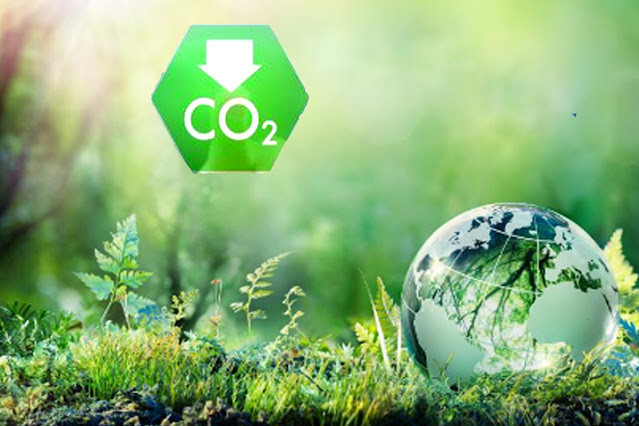Carbon
Introduction The Future of Carbon Capture and Utilization
As the world grapples with the urgent need to address climate change, the future of carbon capture and utilization (CCU) emerges as a crucial solution.
CCU technologies aim to capture carbon dioxide (CO2) emissions from industrial processes and utilize them in innovative ways, mitigating their impact on the environment. This article explores the exciting developments in CCU and highlights the potential it holds for a sustainable and low-carbon future.
Carbon Capture and Utilization: A Primer
Carbon capture and utilization involves the capture, separation, and conversion of CO2 emissions from various sources, such as power plants, manufacturing facilities, and even directly from the atmosphere. This process prevents the release of CO2 into the atmosphere, where it contributes to global warming. Instead, captured carbon can be utilized in a range of applications, thereby creating economic and environmental value.
Advancements in Carbon Capture Technologies
The future of CCU largely depends on the development of efficient carbon capture technologies. Significant strides have been made in this domain, with emerging techniques such as solvent-based capture, solid sorbents, and membrane-based separation showing great promise. These technologies aim to enhance capture efficiency while reducing energy requirements and costs.
Furthermore, the integration of carbon capture systems with industrial processes has gained momentum. For instance, direct air capture (DAC) technology can directly extract CO2 from the atmosphere, presenting an avenue for reducing emissions and achieving negative carbon emissions.
Transforming CO2 into Value-added Products
Captured CO2 can be utilized in a wide range of applications, including:
a. Carbon Utilization in Construction: Carbon dioxide can be used as a precursor for sustainable construction materials, such as carbon-negative concrete. By replacing a portion of cement with CO2, this innovative approach not only reduces emissions but also enhances the durability and strength of the final product.
b. Carbon Utilization in Chemicals and Fuels: CO2 can serve as a feedstock for the production of valuable chemicals and fuels through processes like electrochemical reduction and hydrogenation. These methods hold the potential to transform CO2 from a waste product into a valuable resource, contributing to the development of a circular carbon economy.
c. Carbon Utilization in Agriculture: CO2 can be utilized in agricultural practices to enhance crop growth, reduce water consumption, and improve soil quality. By injecting CO2 into greenhouses or underground, it can stimulate plant growth and increase agricultural productivity.
Overcoming Challenges and Scaling Up
While the potential of CCU is significant, several challenges need to be addressed for widespread adoption and scaling up. These challenges include high capital costs, limited infrastructure, energy requirements, and policy frameworks that support CCU implementation. Collaboration between governments, research institutions, and industry players is crucial to overcoming these barriers and fostering an environment conducive to CCU development.
The Roadmap to a Sustainable Future
The future of carbon capture and utilization is closely linked to the broader transition towards a sustainable and low-carbon future. CCU technologies can play a vital role in achieving carbon neutrality by 2050, as outlined in various international agreements such as the Paris Agreement. Investments in research and development, coupled with supportive policies and incentives, can accelerate the deployment of CCU solutions and drive innovation in the field.
Fact and data of Carbon capture
Fact:
Carbon capture refers to the process of capturing carbon dioxide (CO2) emissions from various sources, such as power plants, industrial facilities, and even directly from the atmosphere, to prevent it from being released into the atmosphere.
Data:
Global CO2 Emissions
According to the Global Carbon Project, global CO2 emissions reached a record high of 36.8 gigatons in 2019.
Industrial Emissions
The industrial sector contributes a significant portion of global CO2 emissions, accounting for approximately 21% of total emissions.
Carbon Capture Capacity
As of 2021, the global carbon capture capacity was estimated to be around 40 million metric tons per year. However, this represents only a fraction of the CO2 emissions produced globally.
Major Carbon Capture Projects
Several large-scale carbon capture projects are currently operational or under development worldwide. Notable examples include the Petra Nova project in Texas, USA, and the Gorgon project in Western Australia.
Utilization of Captured CO2
Captured CO2 can be utilized in various applications. For instance, CO2 is commonly used in enhanced oil recovery (EOR) techniques to increase oil production. Additionally, it can be used in the production of chemicals, building materials, and alternative fuels.
Cost of Carbon Capture
The cost of carbon capture varies depending on the technology used and the specific project. Generally, the cost ranges from $50 to $150 per metric ton of CO2 captured. However, significant cost reductions are expected as the technology advances and scales up.
Policy Support
Governments worldwide are increasingly recognizing the importance of carbon capture and have implemented policies to support its deployment. For instance, the United States offers tax credits and financial incentives for carbon capture projects through the 45Q tax credit program.
Potential CO2 Storage Capacity
The Intergovernmental Panel on Climate Change (IPCC) estimates that the world has the potential to store billions of metric tons of CO2 underground in geological formations, such as depleted oil and gas fields and deep saline aquifers.
Carbon Capture and Sustainable Development Goals
Carbon capture technologies have the potential to contribute to several Sustainable Development Goals (SDGs), including SDG 7 (Affordable and Clean Energy) and SDG 13 (Climate Action), by reducing emissions and supporting the transition to clean energy sources.
Long-Term Climate Goals
Carbon capture is considered an important technology for achieving long-term climate goals, such as limiting global warming to well below 2 degrees Celsius as outlined in the Paris Agreement.
Carbon capture and utilization offers a promising pathway for transforming CO2 emissions from a liability into an opportunity. By capturing and utilizing carbon, we can mitigate climate change, create economic value, and build a more sustainable future. As research and development efforts continue to advance, the future of CCU holds immense potential for reducing emissions, fostering innovation, and paving the way to a carbon-neutral society. It is imperative that stakeholders across sectors collaborate to harness the transformative
https://www.exaputra.com/2023/05/the-future-of-carbon-capture-and.html
Renewable Energy
Saving Electricity
 My father was big on turning off lights because he was frugal.
My father was big on turning off lights because he was frugal.
Another reason, of course, that affects those of us tied to the grid, is to do one’s part in lowering the consumption of fossil fuels.
Renewable Energy
Terra-GEN, Nordex & Siemens Gamesa Improve
Weather Guard Lightning Tech

Terra-GEN, Nordex & Siemens Gamesa Improve
Terra-Gen’s 238.5 MW project in Texas is now fully operational and the Philippines just awarded approvals for more than 10 GWs of renewables. Plus Nordex and Siemens Gamesa are optimistic about their future.
Sign up now for Uptime Tech News, our weekly email update on all things wind technology. This episode is sponsored by Weather Guard Lightning Tech. Learn more about Weather Guard’s StrikeTape Wind Turbine LPS retrofit. Follow the show on Facebook, YouTube, Twitter, Linkedin and visit Weather Guard on the web. And subscribe to Rosemary Barnes’ YouTube channel here. Have a question we can answer on the show? Email us!
There’s news from the wind industry this week. And for once… the headlines tell a story of growth. Down in Hidalgo County, Texas… something worth celebrating happened this week. Terra-GEN commissioned the Monte Cristo ONE Windpower Project. Two hundred thirty-eight-point-five megawatts. Fully operational. The wind facility will generate more than 850 gigawatt-hours of clean electricity every year. Enough to power roughly 81,000 homes. And the power? Already sold. Long-term purchase agreements with two corporate customers. Construction created about 280 jobs at peak activity. More than 490,000 work hours. Not one lost-time incident. They upgraded 11 miles of state roads. Twenty-five miles of county roads. Over its lifetime… the project will deliver more than 100 million dollars to the local community. Property taxes. Landowner payments. Other economic contributions. “It is an honor,” said John O’Connor, Chief Financial Officer for Terra-GEN, “to celebrate the hard work and dedication of the hundreds of men and women who made the commissioning of the Monte Cristo wind project possible.” Meanwhile… halfway around the world in the Philippines… the government just awarded approvals for more than 10 gigawatts of renewable power. That’s ten-point-two gigawatts, to be exact. One hundred twenty-three winning bidders. Solar. Storage. And wind. Onshore wind alone claimed two-point-five gigawatts of that capacity. Twenty-one projects. All set to deliver power by 2029. The Philippines is targeting 50 percent renewable generation by 2040. And they’re not waiting around. The “overwhelming response,” said the department of energy, “reflects the growing confidence of investors.” Back in Europe… in Germany… Nordex is making moves. The turbine manufacturer just secured orders for 123 megawatts from Denkerwulf. Twenty-five onshore wind turbines. Installation begins in 2027. Commissioning in 2028. And Nordex shares? They’re climbing. Hit a multi-year high this week. Trading at 28 euros and 2 cents. Denkerwulf’S orders for Nordex in 2025 now total nearly 144 megawatts. And last week… Mingyang signed a contract with ORE Catapult… a state-owned British test center. They’re going to test main bearings for Mingyangs offshore 18.5MW turbines in the United Kingdom. “A major milestone,” said Mingyang’S chief technology officer for Europe, Marc Sala. “A decisive breakthrough for our local operations.” Mingyang has big plans for Britain. One-point-five billion pounds in investments. Half for factories. Half for the offshore wind supply chain. Now… over at Siemens Gamesa… things are looking up. The wind business has been struggling. Over four fiscal years… losses totaled eight-point-six billion euros. But Chief Executive Officer Christian Bruch confirmed this week… they’re still targeting profitability by 2027. Break-even by 2026. Revenue for full-year 2025 rose 5 percent to ten-point-three-seven-five billion euros. Losses improved slightly. “The journey towards profitability is going to take time,” said Chief Financial Officer Maria Ferraro. “But I think the team is doing a great job.” They expect a positive fourth quarter in 2026. So there you have it. The wind industry is pushing forward. Two hundred thirty-eight-point-five megawatts commissioned in Texas. One hundred twenty-three projects approved in the Philippines. One hundred twenty-three megawatts ordered in Germany. Eighteen-point-five megawatt turbines heading to Britain for testing. And Siemens Gamesa … now seeing light at the end of the tunnel. The numbers tell the story. Things are beginning to stabilize – and there’s hope for the future. That’s the state of the wind industry on the 17th of November 2025. Join us tomorrow for the Uptime Wind Energy podcast.
https://weatherguardwind.com/terragen-nordex-siemens/
Renewable Energy
Has the Fever Broken?
 Many Americans are starting to feel like the lady whose observations we see at left.
Many Americans are starting to feel like the lady whose observations we see at left.
Exactly how this moves forward from here is anyone’s guess. Maybe the Democrats gain a huge majority in Congress in 2026 and then impeach and convict Trump–perhaps joined by lots of Republicans.
There are plenty of different scenarios.
-
Climate Change3 months ago
Guest post: Why China is still building new coal – and when it might stop
-
Climate Change2 years ago
Spanish-language misinformation on renewable energy spreads online, report shows
-
Greenhouse Gases3 months ago
Guest post: Why China is still building new coal – and when it might stop
-

 Greenhouse Gases1 year ago
Greenhouse Gases1 year ago嘉宾来稿:满足中国增长的用电需求 光伏加储能“比新建煤电更实惠”
-
Climate Change Videos2 years ago
The toxic gas flares fuelling Nigeria’s climate change – BBC News
-

 Climate Change1 year ago
Climate Change1 year ago嘉宾来稿:满足中国增长的用电需求 光伏加储能“比新建煤电更实惠”
-

 Carbon Footprint2 years ago
Carbon Footprint2 years agoUS SEC’s Climate Disclosure Rules Spur Renewed Interest in Carbon Credits
-
Renewable Energy4 months ago
US Grid Strain, Possible Allete Sale





